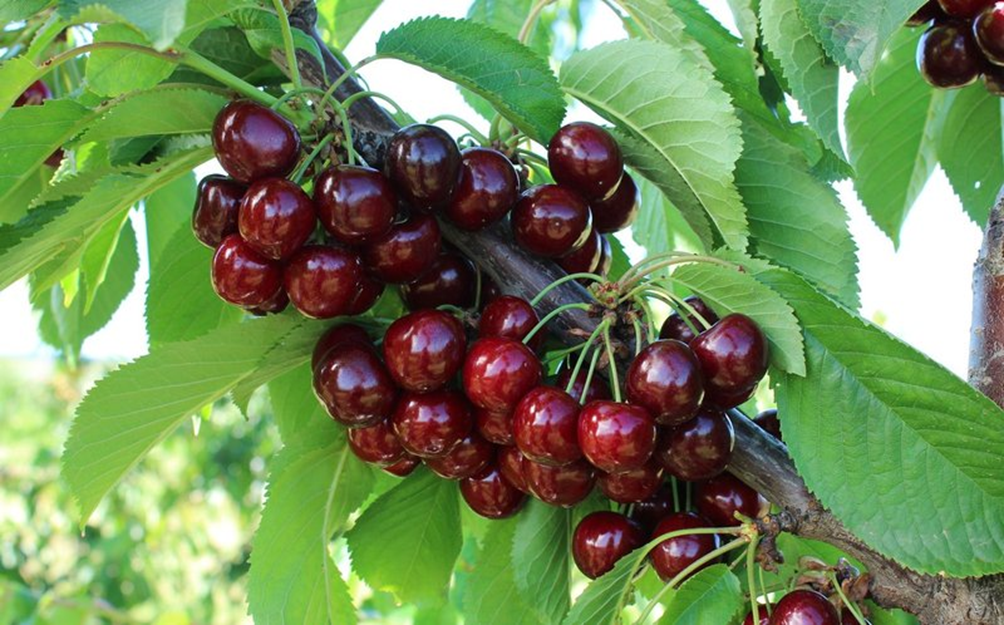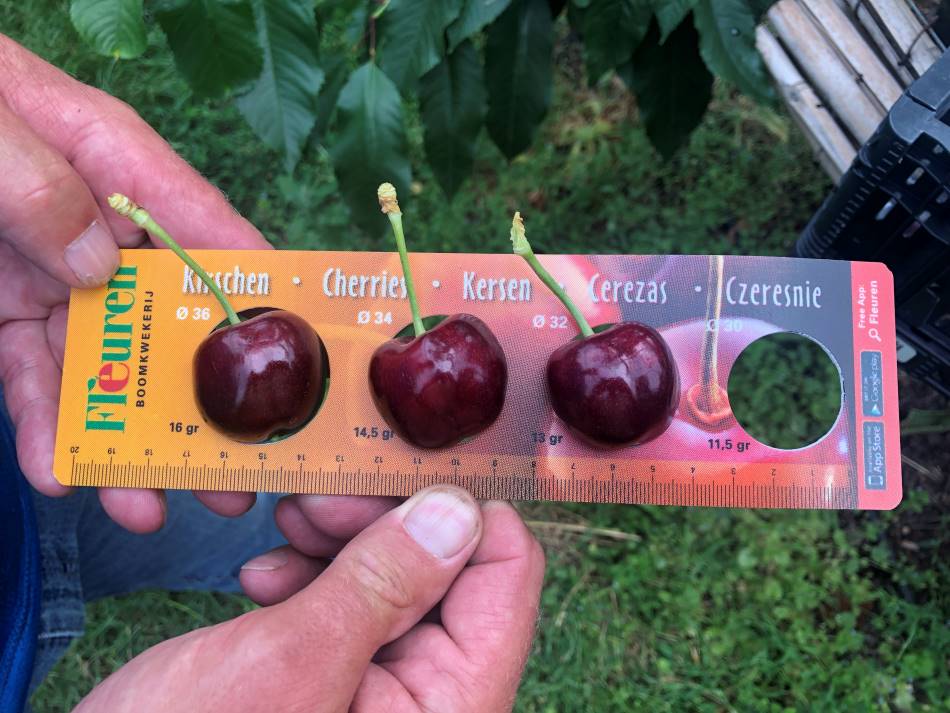At the last Cherry Expo, ANA Chile researchers reported on the behaviour of some new early cherry varieties that are rapidly establishing themselves in new cherry orchards in Chile. Below are the main technical indications for producers and exporters that emerged during the Chilean symposium organised by ANA Chile.
NIMBA*

Harvest date information
The criterion for choosing the harvest date is based on the colour1 of the epidermis. For Nimba*, colour code 3 (mahogany red) is indicated. It is recommended not to exceed colour code 3.5 at harvest because by colour 3.5 (Santina colour) the fruit will have already lost 2 to 3 Durofel consistency points.
Useful considerations for defining the fruit load
Nimba* exhibits a high earliness of entry into production. Furthermore, it is a very fertile variety with a high fruit set percentage: 30-40% on average on Gisela and MaxMa and 25-30% on average on Colt. The fruits are large in size: 12 g on average.
Recommendations for maximum fruit loads for cherry orchards planted in 2020 (III leaf)
To avoid fruit softening, it is recommended not to exceed 3.0-4.5 kg/plant. Aim for a maximum production yield of 4-6 t/ha depending on planting density and rootstock. Controlling the production load through pruning, bud suppression, flower thinning and, as a last resort, fruit thinning is recommended.
Quality considerations for export cherries
In order to guarantee the highest quality level of cherries cv Nimba*, it is recommended to market fruit with the following characteristics: minimum soluble solids level of 17°Brix; skin colour code 3 (mahogany red) or maximum 3.5 (Santina red); minimum fruit size in the 26-28 mm class; minimum fruit firmness index 70 Durofel, at room temperature.
1 - Colour table and sizes of the UC 2022 cherry tree - Laboratorio de Poscosecha. Depto de Fruticultura y Enología. Pontificia Universidad Catolica de Chile.
SWEET ARYANA® PA1UNIBO*

Harvest date information
The criterion for selecting the harvest date is based on the colour1 of the epidermis and the soluble solids content. For Sweet Aryana® the colour code 3.5 (Santina red) is indicated, with a minimum of 19°Brix for shipments by ship and a minimum of 20-21°Brix for shipments by air. It is recommended not to pick fruit with colours below 3.5 to ensure an adequate sugar-acid ratio.
Useful considerations for defining the fruit load
Sweet Aryana® has an intermediate earliness of entry into production. Furthermore, it is a very fertile variety with a high fruit set percentage: 25-30% on average on Gisela and MaxMa and 15-20% on average on Colt. Sweet Aryana® trees are very vigorous. The fruits are large in size: 11g on average.
Recommendations for maximum fruit loads for cherry orchards planted in 2020 (III leaf)
It is recommended not to exceed 3.0-3.2 kg/plant. Aim for a maximum production yield of 3-5 t/ha depending on the planting density and rootstock.
With an adequate fruit load on the tree and a timely harvest date, Sweet Aryana fruit should meet the following parameters: epidermis colour scale 3.5 (Santina red); minimum soluble solids of 19°Brix for shipments by ship and 20-21°Brix for air shipments; minimum fruit size of 28 mm; average fruit firmness of 75 Durofel, at room temperature.
Quality considerations for export cherries
In order to guarantee the highest quality level of Sweet Aryana® cherries, we recommend marketing fruit with the following characteristics: minimum soluble solids level of 19°Brix for shipments by ship and 20-21°Brix for shipments by air; minimum fruit size greater than 24 mm; average fruit firmness of 75 Durofel, at room temperature.
1 - Colour table and sizes of the UC 2022 cherry tree - Laboratorio de Poscosecha. Depto de Fruticultura y Enología. Pontificia Universidad Catolica de Chile.
FRISCO*

Harvest date information
The criterion for choosing the harvest date is based on the colour1 of the epidermis. For Frisco*, colour code 3 (mahogany red) is indicated. It is recommended not to exceed colour code 3.5 at harvest because by colour 3.5 (Santina red) the fruit will have already lost 2 to 3 Durofel consistency points.
Useful considerations for defining the fruit load
Frisco* has an intermediate earliness of entry into production. Furthermore, it is a medium-high fertility variety with a high fruit set percentage: 25-30% on average on Gisela and MaxMa and 15-20% on average on Colt. The fruits are large in size: 11g on average.
Recommendations for maximum fruit loads for cherry orchards planted in 2018 (V leaf)
To avoid softening of the fruit, it is recommended not to exceed 4.2-14 kg/plant, depending on the rootstock. Aim for maximum yields of 8-10 t/ha with Gisela, 10-12 t/ha with MaxMa and 12-14 t/ha with Colt.
Recommendations for maximum fruit loads for cherry orchards planted in 2019 (IV leaf)
To avoid softening of the fruit, it is recommended not to exceed 2-6 kg/plant, depending on the rootstock. Aim for maximum yields of 4-6 t/ha with Gisela, 5-7 t/ha with MaxMa and 6-8 t/ha with Colt.
With an adequate fruit load on the tree and a timely harvest date, Frisco* fruit should meet the following parameters: epidermis colour scale 3 (mahogany red); minimum soluble solids of 17°Brix; minimum fruit size of 28 mm; average fruit firmness of 70 Durofel, at room temperature.
Quality considerations for export cherries
In order to guarantee the highest quality level of cv Frisco* cherries, it is recommended that the fruit be marketed with these characteristics: minimum soluble solids level of 17°Brix; skin colour from 3 (mahogany red) to maximum 3.5 (Santina red); minimum fruit size greater than 26 mm; average fruit firmness of 70 Durofel, at room temperature, both for air and naval shipments.
1 - Colour table and sizes of the UC 2022 cherry tree - Laboratorio de Poscosecha. Depto de Fruticultura y Enología. Pontificia Universidad Catolica de Chile.
Final remarks
In Nimba*, we have to prevent low fruit firmness due to overloading of the trees; early harvesting, without adequate colour or °Brix; softening of the fruit, avoiding the use of plastics after the fruit has turned straw colour.
In Sweet Aryana® we have to prevent early harvesting, which leads to fruit with increased acidity; softening of the fruit produced by over-production of the trees and the use of plastic after the straw colour of the fruit.
In Frisco* we have to prevent low fruit firmness due to overloading of the trees; early harvesting, without adequate colour or °Brix; softening of the fruit, avoiding the use of plastics after the straw colour of the fruit; generation of sutures in the fruit due to water stress in the previous season.
Source: ANA Chile
Images: ANA Chile
Cherry Times - All rights reserved















